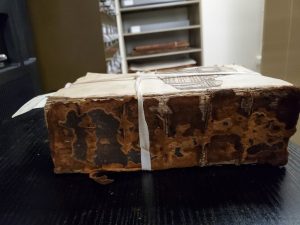By Emily Petermann, Library Assistant
Lots of important events happen in the month of October: Halloween, National Chocolate Day, John Adams’ 288th birthday, and . . . American Archives Month! For today’s blog post we’re celebrating American Archives Month and embracing the spookiness of Halloween by investigating what haunts the hallowed halls (and librarians) of the MHS.
Redrum….rot?
For years, employees have walked through seemingly endless rows of shelving that make up the storage in the MHS building; rows that are stacked nearly floor to ceiling with boxes, with call slips to mark removed materials in hand, and a book truck to cart materials back and forth from the stacks to the Reading Room.
But something else wanders those shelves too- and has since the Society moved to 1154 Boylston Street in 1899.
Once the staff leave the stacks, and the rows of shelves again lie under cover of darkness, something else prowls the shelves. It touches many books in the collection, trailing its rusty fingertips along the shelves as it wanders the aisles.
On this chilly October morning, a librarian enters the stacks. They shiver with the temperature difference- going from the 124-year-old main building to the climate-controlled stacks can be a shock on any morning. (Seriously, the scariest thing in our building may be the AC. When you visit, we recommend bringing a sweater to fend off the cold!)
But is it just the temperature, with what we know is lurking?
Fortunately for the librarian, they only have one item to pull–a bound volume from the 1850s. They stride in confidently, knowing exactly where this volume will be. But what they don’t know is that the volume will be high up on the top shelf, well above their head. It’s a common occurrence with shelves from floor to ceiling, to have to stretch (or grab the squeaky stepstool) to reach materials. So, they sigh, reach up as high as they can, and give the book a gentle tug to pull it off the shelf.
That’s when it strikes.
Red spots of digested and disintegrating leather flow from the book, hanging in a haze in the air, and shower the librarian and the shelves. Red spots cover the librarian’s hair and face, cover the cardigan they wear, and stain their white shirt. They look, to be frank, like a murder has occurred in the hallowed halls of the MHS.
They have encountered red rot.
After a quick pause to think through what they were just showered with, all the librarian can do is sigh and put the call slip back where the volume had sat. This throws up another puff of the red dust that has accumulated where the book has been sitting. They bring the book down to the Reading Room for the researcher to use and begin a futile attempt to get the leather particles of their clothing without staining. This book will require everyone who handles it to wash their hands, making the water run red with the decay that has happened in the stacks.

Red rot is a form of decay that can happen to vegetable-tanned leather items. It’s a natural effect of the leather aging, which means that it’s touched quite a few volumes in our collection. We keep all of our materials in dark, climate-controlled spaces to slow down this natural process and make sure any volumes get preservation attention as needed. Want to know more about red rot? Check out Explore Libraries and Archives Mutual Ltd.’s article here.
You are being watched.
The stacks are a funny place- between the rows and rows of shelving, the concrete floors, and different doorways in and out of the stacks, you can never truly tell when you are alone. Footsteps echo through the floors, sometimes sounding as if someone has walked directly behind you as you scan the shelves. Doors that are floors away slam as if they were right next to you, and yet coworkers can accidentally sneak up behind you without realizing someone else had stepped onto the floor.
Having shaken off their encounter with red rot, the librarian steps back into another floor of stacks to search for another box. Just as the door closes behind them, the lights finally flicker on and faintly–very faintly–they hear the sound of footsteps. Probably from one of the other stacks upstairs, but it still sets their nerves on edge.
They carefully pick through the stacks, looking for the correct collection. Somewhere in the stacks, there are more footsteps–a quick glance around still doesn’t calm their nerves. As they round the end of an aisle, something flits through the corner of their eye. Something different.
There is someone else in the stacks.
Someone tall, ghostly pale, who was not there just moments ago. Someone who is staring directly down the aisle.
Over the 232 years (9 months, 4 days) that the MHS has existed, it has collected some . . . interesting items. Most of them are exceedingly cool–when you’re expecting them. There are a few items that tend to sneak up on you. Especially when you consider the fact that they . . . are everywhere. We’ve tucked items into every (climate controlled, secure) nook and cranny that we have! You are almost always within 10 feet of someone’s portrait or bust, supervising you as you work. When they move, it can catch you off guard.

Meet Jared Sparks. Or rather, Jared Spark’s bust, based on the original made by Hiram Powers in 1857. Spark’s bust used to sit on the floor with other busts in the collection, but was recently put up on a pedestal, creating the illusion of a stranger in the stacks.
We hope you have a safe and happy Halloween!
If you’re looking for more spooky stories about the MHS, check out this blog post: Scary Stories to Tell in the Stacks.

